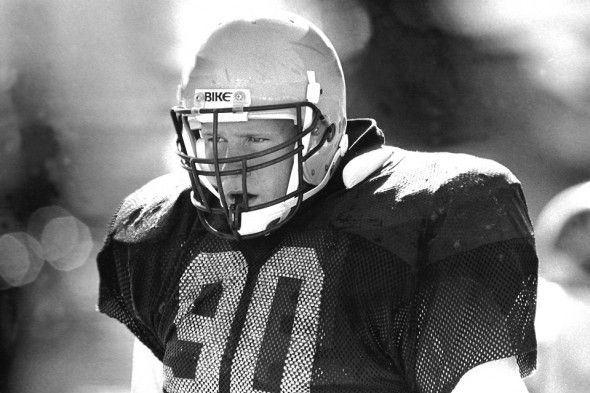
By David Eskenazi and Steve Rudman
Between 1935 and 1971, only six women received Man/Star of the Year awards (78th MTR Western Sports Star of the Year is Friday at Benaroya Hall). One of the six, swimmer Lynn Colella, had to share it with her younger brother, Rick. From Colella’s 1971 award through 1994, not a single woman won, although dozens were nominated, including synchronized swimmer Tracie Ruiz-Conforto a record four times in the 1980s.
The major obstacle faced by deserving female (and amateur) athletes: they simply couldn’t win what had become a popularity contest when pitted against high-profile professionals, or even University of Washington football players.
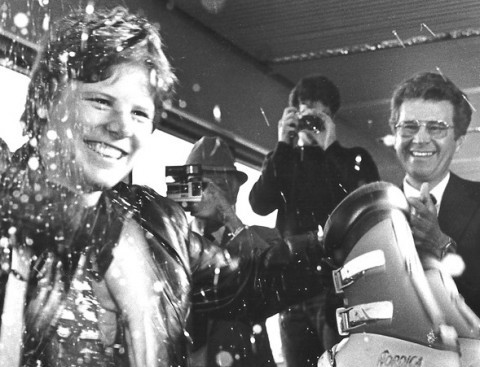
Thus, numerous gifted female athletes found themselves shut out. In addition to Ruiz-Conforto, winner of multiple Olympic medals, the “losers” included world figure skating champion and Olympic silver medalist Rosalyn Sumners (1984), Olympic downhill gold medalist Debbie Armstrong (1984), world championship cyclist Rebecca Twigg, champion diver Ellen McGrath and World Cup soccer star Michelle Akers.
The sponsoring Seattle Post-Intelligencer decided to change the voting format in 1994 by honoring male and female athletes with separate awards, with the intent of giving more recognition to amateur athletes, particularly women.
Pat Lesser Harbottle, the first woman named Man of the Year (the name the program went by from 1935-76) in 1955 (see Wayback Machine: Sports Star of Year 1960-69), embraced the change.
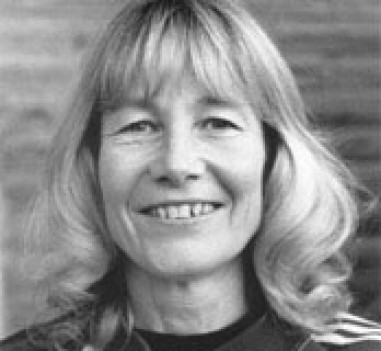
“I think its a marvelous idea,” the former three-time U.S. Womens Amateur golf champion told the Post-Intelligencer. ”It’s a wonderful way to recognize their (female athletes) accomplishments.”
“I commend the P-I for being willing to change the format and trying something new that might work well,” added 1970 winner Doris Brown (Heritage). ”I don’t think you can ever have too many awards.” (see Wayback Machine: Sports Star of Year 1970-79)
While various Mariners (5), UW athletes (4) and one Sonic dominated the ballot in the 1990s, the format change enabled two female nominees, who hadn’t been able to win head-to-head against men, to capture Star of the Year awards when grouped into their own category.
1990 / GREG LEWIS, UW Football
With various Seahawks claiming five of the 10 Star of the Year awards in the 1980s, it had been more than a decade (Joe Steele, 1979) since voters went for a University of Washington running back. Greg Lewis took care of that by prevailing over a slate that included hydroplane legend Chip Hanauer, on the ballot for the third and what would be the final time.
By 1990, Hanauer had won four (of his eventual seven) national driving championships, seven (of an eventual 11) APBA Gold Cups and five (of an eventual seven) Seafair Trophy races, but had never been able to break through at the Star of the Year.
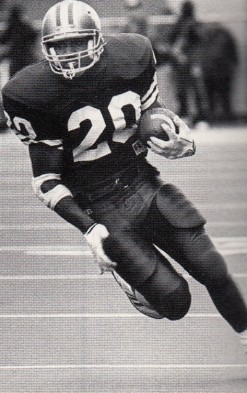
Another driver on the 1990 ballot, the previously non-descript auto racer Derrick Cope of Spanaway, scored the biggest breakthrough of his career when he upset Dale Earnhardt to win the Daytona 500, becoming the first driver from the state to capture NASCAR’s most prestigious race.
The rest of the ballot featured the usual assortment of Seahawks (safety Nesby Glasgow), Sonics (Shawn Kemp) and Mariners (18-game winner Erik Hanson), as well as Longacres jockey Vann Belvoir, UW basketball star Karen Deden, and one administrator, Bob Walsh, responsible for bringing to Seattle the most elaborate athletic extravaganza held in the city, the 1990 Goodwill Games.
The Goodwill Games not only involved competitions in a variety of summer and winter Olympic sports featuring the top athletes from the U.S. and Soviet Union, but major exhibitions and special events: Treasures of Moscow art exhibit, a summer-long appearance by the Bolshoi Ballet, and the largest cultural exchange ever held between the USA and Soviet Union.
But the Star of the Year had become all about public profile and popularity, and Lewis fit the bill. He rushed for 1,407 yards, made five All-America teams and won the Doak Walker Award, given to the nation’s top running back (to put Lewis’s selection in perspective, subsequent Doak Walker winners included Eddie George, Ricky Williams, LaDainian Tomlinson and Reggie Bush).
More significant, in terms of Star of the Year voting patterns, Lewis rushed for 128 yards in Washington’s 46-34 romp over Iowa in the 1991 Rose Bowl. Every time Washington won a Rose Bowl, its Man/Star of the Year nominee followed with a victory at the awards program.
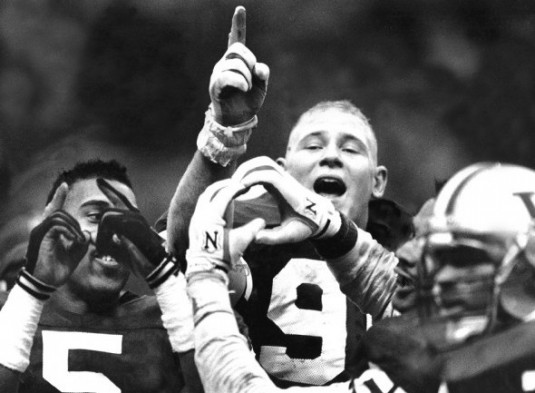
1991 / STEVE EMTMAN, UW Football
The 1991 Star of the Year ballot featured the greatest defensive tackle in Seahawks history, a future member of the U.S. Soccer Hall of Fame and an athlete who would become the most popular pro sports figure in Seattle sports history. None had a chance against the 1991 winner, although, in hindsight, it was hard to argue against any of them.
Cortez Kennedy was voted to the first of eight Pro Bowls and was a year away from becoming the Associated Press Defensive Player of the Year. Michelle Akers, a Shoreline product, scored 39 goals in 26 games for the 1991 U.S. women’s soccer team, including a staggering 10 (five in one game) in the Women’s World Cup in China. And Edgar Martinez of the Mariners had two AL batting titles in his future, as well as an unforgettable double that saved Seattle from losing major league baseball.
But few athletes mesmerized a city over one season quite like Steve Emtman, his dominating play at defensive tackle for the UW’s co-national championship football team best epitomized by his brazen actions Oct. 5, when Arizona visited Husky Stadium.
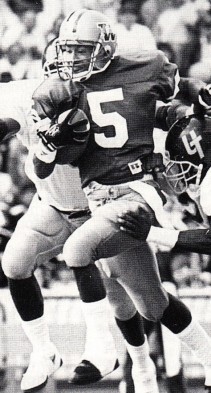
On the first scrimmage play in what became a 54-0 UW rout, Emtman shook off a double team, broke through the line and flattened Wildcat quarterback George Malauulu before he could hand the ball off. Emtman then said to Malauulu, ”I’ll be back.” To which Malauulu replied, “I know.”
Next play, same thing. Before the third play, Malauulu called a timeout. The roar at Husky Stadium was never louder.
”It’s ridiculous,” Arizona coach Dick Tomey told reporters. ”We think we’ve got the schemes to handle him and he’s in our backfield the first two plays of the game.”
Which was why Emtman became the ninth player in college football history to win the Outland Trophy and Lombardi Award in the same season, and also why he became the only football player in school history taken No. 1 overall in the NFL draft.
Due to numerous injuries, Emtman didn’t have much of a career as a pro. But he entered both the College Football Hall of Fame and Rose Bowl Hall of Fame in 2006.
1992 / EDGAR MARTINEZ, Baseball
Seattle native and PGA veteran Fred Couples never had a better chance to win the Star of the Year than in 1992. That year, Couples won his first Grand Slam event, taking The Masters by escaping a near disaster at Amen Corner (12th hole).
In the weeks leading up to Augusta, Couples won the Nissan Los Angeles Open, defeating Davis Love III in a playoff, and finished second in two other events. Couples was named the PGA Player of the Year and also won the Vardon Trophy (PGA leader in scoring average) and Byron Nelson Award (lowest adjusted scoring average).
For 16 weeks, he roosted atop the World Golf Rankings, the first American to reach that summit since world rankings were instituted in 1986.
But Couples’ fantastic year couldn’t pull enough voters away from Edgar Martinez of the Mariners, who triumphed over a field that included Olympic kayak bronze medalist Greg Barton of Seattle, Shawn Kemp of the SuperSonics (second time on the ballot), Pro Bowl defensive tackle Cortez Kennedy of the Seahawks (also a second-time nominee), Olympians diver Ellen McGrath and cyclist Rebecca Twigg, and Seattle U. basketball star LaShanna White.
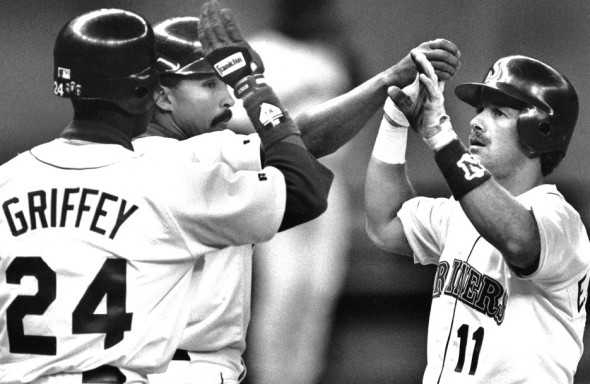
Barton, a double gold medalist in 1988 at Seoul, won a bronze in K-1 1000 in Barcelona. Kemp averaged 15.5 points and 10.4 rebounds for the Sonics. Kennedy was selected AP Defensive Player of the Year on a two-win Seahawks team.
McGrath finished seventh in platform diving in Barcelona, where Twigg won a bronze in individual pursuit. White, reaching the Star of the Year finals for a second time, again was named an NAIA All-America.
The most remarkable story belonged to Tony Volpentest, born without hands or feet. But by living his own message — “If you can dream it, you can achieve it” – Volpentest became a sensational athlete. At the 1992 Barcelona Paralympic Games, he won gold medals in the 100- and 200-meter sprints, setting world records in each.
Martinez, though, was the first batting champion in Mariners history, hitting .343 with 181 hits, including an AL high 46 doubles, 18 home runs and 73 RBIs. Martinez also was named to the first of his seven AL All-Star teams, and won the first of five Silver Slugger awards.
Star of the Year voters obviously didn’t care that Martinez played for a team that finished 64-98.
1993 / RANDY JOHNSON, Baseball
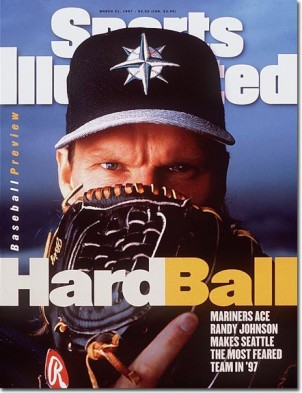
For the first time in the history of the Star of the Year, four women became nominees, including, for the third consecutive year, Seattle U. basketball marvel LaShanna White, a 6-3 center brought into the Chieftains program by head coach Dave Cox, who discovered White in a 7-11 convenience store where she worked.
A Louisiana native, White attended a Seattle community college and had a well-deserved reputation as a playground legend. Cox saw she had all the athletic skills necessary to succeed at Seattle U., but that her techniques required refinement. Three years later, White averaged 25.3 points and was a two-time All-America.
As competition for Sports Star of the Year, Seattle Pacific offered up Karin Grelsson, winner of the heptathlon at the NCAA Division II Track and Field Championships; Washington presented Rhonda Smith, the UW women’s team’s leading scorer and rebounder. Yueh-Chun Chang also made the finals for her feats as a powerlifter (national titles in classes from 111 to 114 pounds).
Also on the ballot: Kemp for a third time; safety Eugene Robinson of the Seahawks, Seattle Pacific soccer star Jason Dunn, who led his team to a Division II title; and Napoleon Kaufman, UW star running back.
Randy Johnson’s major league-leading 308 strikeouts for the Mariners trumped all. Johnson posted a 19-8 record with a 3.24 ERA in 34 starts, just the launch of what would become an awesome career statistical avalanche.
Johnson also topped the majors in batting average against (.203), fewest hits per nine innings (6.52), strikeouts per nine (10.9) and finished second in shutouts with three.
On May 16 at Oakland, Johnson fired a one-hitter with 14 strikeouts. From May 11 through May 21, he recorded 20 consecutive scoreless innings. And from Aug. 14 through the end of the season, Johnson went 8-0 with a 2.11 ERA and a save in his final 11 games.
Johnson did not win the first of his five Cy Young awards until 1995, when the Mariners won their first division title. But the Big Unit was ineligible for Star of the Year consideration by then, program policy being no repeat winners allowed.
1994 / NAPOLEON KAUFMAN, Football
1994 / RHONDA SMITH, Basketball
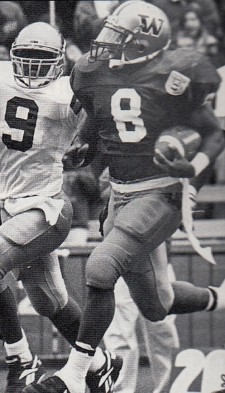
Rhonda Smith came to the UW from Franklin High and departed in 1995 as the school’s all-time leading scorer (1,801 points) and third-leading rebounder (803). Known for her accuracy, she had a career shooting percentage of .530 and remains the only Husky to lead a team in field goal percentage for four years.
Behind Smith, the UW women went 80-40 and made three trips to the NCAA Tournament. She also led the Huskies to a preseason NIT crown, earning MVP honors with 38 points in the title game against Texas Tech.
Despite a portfolio jammed with achievement, Smith never would have won a Star of the Year award if the sponsoring Post-Intelligencer hadn’t changed the voting format in 1994 by creating a separate award for women athletes women. Smith became the first Female Sports Star of the Year, joining Male Sports Star of the Year Napoleon Kaufman, giving the Huskies a double win.
On the ballot for a second time, Kaufman was the most productive running back in school history, amassing 4,106 yards and 34 touchdowns. He was the first UW runner to produce three consecutive 1,000-yard seasons — 1,129 in 1992, 1,357 in 1993 and 1,480 in 1994 — and the first named first-team All-Pac-10 three years in a row.
In winning the Male Star of the Year, Kaufman out-polled a field that included Mariners right fielder Jay Buhner (21 home runs, 68 RBIs), Sonics guard Gary Payton (16.5 points, 6.0 assists, first-time NBA All-Star), and Seahawks running back Chris Warren (AFC high 1,545 yards, 11 TDs). Buhner, Payton and Warren all made their first appearances on the Star of the Year ballot.
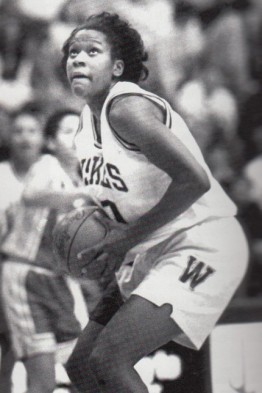
Smith won out over Aryls Johnson, a weightlifter who earned six national championships; Angie Marzetta, UW softball team’s leading batter; twin sisters Betsy and Mary McCagg, Kirkland rowers who had won gold medals at an international regatta in Switzerland, and Cheryl Taplin, a Seattle sprinter out of Cleveland High who led Louisiana State to an NCAA title.
Kaufman had a six-year NFL career (4,792 yards, 12 TDs) after the Oakland Raiders selected him in the first round (18th overall) in the 1995 draft. Smith played professionally overseas and in the WNBA for the Sacramento Monarchs and in the American Basketball League for the Seattle Reign.
1995 / LOU PINIELLA, Baseball
1995 / CHRIS GOBRECHT, Basketball
In advance of 1995 voting, Mariners broadcaster Dave Niehaus treated Star of the Year banquet goers to a narration of video highlights of the team’s AL West championship season. Rousing applause greeted each visual snippet, especially the one showing Edgar Martinez banging what became the most famous double in Northwest history.
No way could UW consensus All-America safety Lawyer Milloy (named to nine first teams) overcome the emotion generated by those highlights. Gary Payton, the Sonics guard who had been named an NBA All-Star for the second time, couldn’t either. Running back Chris Warren of the Seahawks, back on the ballot for a second time (along with Payton), also had no chance.
Mariners manager Lou Piniella overwhelmingly gathered the most votes, becoming the fourth representative of the franchise in a seven-year span to win a Star of the Year award, joining Ken Griffey Jr. (1989), Edgar Martinez (1992) and Randy Johnson (1993).

In his third season in Seattle, Piniella guided the Mariners to their first division title, a feat for which he was named AL Manager of the Year. His club, improbably, wiped out an early-August, 13-game deficit, forced a memorable one-game showdown with the California Angels for the division crown, then defeated the Yankees in an even more memorable five-game series.
The Female Star of the Year, UW women’s basketball coach Chris Gobrect, won over a slate that included Stephanie Armitage-Johnson, a former national weightlifting champion and UW strength coach who was a member of the first all-female crew to compete for sailing’s America’s Cup; Robin Byrd-Goad, a Sumner grade school teacher who won a seventh national weightlifting championship; twin-sister rowers Betsy and Mary McCagg, who won a Pan American gold medal and a national championship in pairs; and cyclist Rebecca Twigg, on the ballot again for regaining the world record in individual pursuit.

Graduates of Lakeside High, the McCaggs could have become outstanding additions to the UW rowing program. But their family history precluded it. When the twins first visited Harvard as potential freshmen in 1986, they discovered a photograph of their grandfather, Class of 1922, on the wall of the Weld Boat House. He had been a Harvard captain, as was their father, Edward, Class of 1957, and also an uncle, Louis, Class of 1952.
So the McCaggs enrolled at Harvard, became All-America selections, then competed for the U.S. national team for a decade. They had five Olympic appearances between them, and both entered Harvard’s Rowing Hall of Fame in 2004.
But the 1995 Female Star of the Year belonged to Gobrecht, who guided her Huskies to a 25-9 record, a ninth trip to the NCAA Tournament and reached her 300th victory as the second-fastest of any coach in women’s college basketball history.
1996 / ALEX RODRIGUEZ, Baseball
1996 / MICHELLE AKERS, Soccer
Most Mariners fans who watched Ken Griffey Jr. blossom into greatness between 1989-95 thought they would never see his likes in a Seattle uniform again — until they laid eyes on Alex Rodriguez. Then they wondered whether they might be watching a player with even more upside than Junior.
Despite Griffey’s 49 home runs and 140 RBIs in 1996, the story that year was Rodriguez.
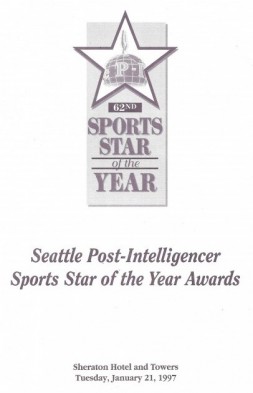
The 20-year-old shortstop led the AL in batting with a .358 average, best in franchise history. He swatted 36 home runs, 14 more than Griffey produced at age 20.
He led the AL with 141 runs scored and earned a Silver Slugger award. Griffey hadn’t won his first until age 21.
Rodriguez registered all-time bests for a major league shortstop in hits (215), doubles (54), extra-base hits (91), total bases (379) and slugging percentage (.631).
Rodriguez was named Sporting News Major League Player of the Year, an award Griffey wouldn’t win until age 27.
Rodriguez finished second in Most Valuable Player voting, and award he would have won if either of Seattle’s baseball beat writers, Bob Finnigan of the Times and Jim Street of the Post-Intelligencer, voted for him.
Rodriguez had nothing to worry about at the 1996 Star of the Year program, more than 1,000 voters at the Sheraton Hotel overwhelmingly going for him. Rodriguez received 544 votes, a 400-vote margin of victory over Paralympic sprinter Tony Volpentest, who followed up his two sprinting golds in Barcelona with two more in Atlanta.
The other male nominees included Washington’s Pac-10 Defensive Player of the Year, Jason Chorak; Sonics coach George Karl, who guided his team into the NBA Finals opposite Michael Jordan and the Chicago Bulls, and DE Michael Sinclair of the Seahawks.
Corey Dillion was as conspicuous by his absence from the 1996 ballot as Alpine skier Phil Mahre had been in 1983, when he won his third consecutive World Cup overall title. Dillon put up the greatest season by a Husky running back: 1,695 yards and 24 touchdowns, including an NCAA record 222 yards in one quarter against San Jose State.
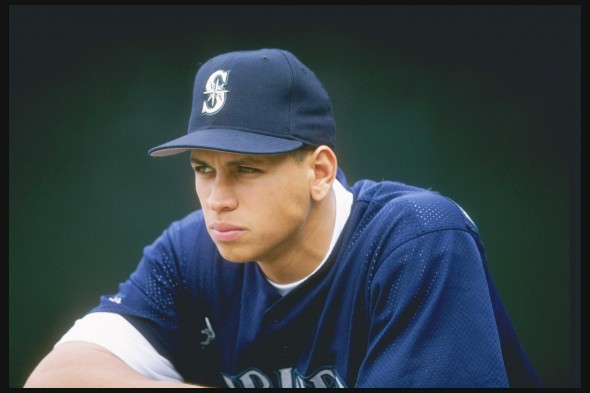
Accompanied to the banquet by his mother, Lourdes Navarro, Rodriguez became the fifth Mariner in seven years to win the Star of the Year, following Griffey (1989), Edgar Martinez (1992), Randy Johnson (1993) and Lou Piniella (1995).
Michelle Akers, a nominee in 1991 after scoring 10 goals at the Women’s World Cup in China, outdistanced another Michelle, the UW’s Church, a softball All-America, to claim the women’s award. Akers also won by a wide margin, 364 votes to 129.
A Shorecrest graduate who learned most of her soccer skills while growing up in Lake Forest Park, Akers became the second soccer winner, following Seattle Pacific coach Cliff McCrath, the winner in 1986 (see Wayback Machine: Sports Star of Year 1980-89).
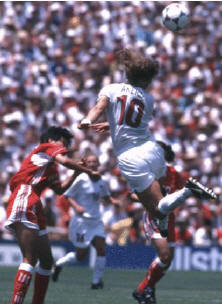
Rodriguez became a 14-time All-Star, a three-time MVP, and a Seattle pariah for bailing in free agency following the 2000 season.
Akers lasted another four years in her sport before retiring. In 2002, FIFA named Akers its Female Player of the Century.
1997 / GARY PAYTON, Basketball
1997 / KATE STARBIRD, Basketball
Gary Payton first appeared on the Star of the Year ballot in 1994, finishing well back of the UW’s Napoleon Kaufman. He reappeared in 1995, when he was named to the NBA’s All-Defensive team, but couldn’t overcome a surge of sentiment for the Mariners and Piniella. Oddly, Payton did not make the Star of the Year finals in 1996, after he won the biggest individual award of his career, the NBA Defensive Player of the Year.
But he made the finals again in 1997, when he became an easy victor over UW receiver Jerome Pathon, Washington State football coach Mike Price, safety Darryl Williams of the Seahawks and Mariners catcher Dan Wilson.
Pathon set two significant Husky records: most catches in a season (73) and most yards (1,299). Price guided his Cougars to their first Rose Bowl appearance in 67 years, Williams led the AFC in interceptions with eight, and Wilson batted a career-high .270 for a Mariner team that won its second division championship.
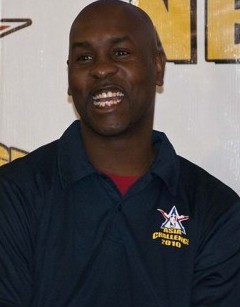
Payton was named an All-Star for the fourth time, to the NBA’s All-Defensive first team for a fourth time and, more important, sparked the Sonics to a 57-25 record and a Pacific Division title.
When Kate Starbird won Female Star of the Year, it marked the first time two basketball players had prevailed at the banquet.
Starbird, a Lakes High (Tacoma) graduate, won the 1997 Naismith Trophy while performing for Stanford, where she was the school’s all-time leading scorer and a two-time, first-team All-America choice.
She out-polled an outstanding slate of women candidates. Heptathlete Kelly Blair, a 1996 Olympian, won the USA Outdoors title in her specialty by scoring a personal record 6,465 points. Jan Harville, Washington women’s rowing coach, led the Huskies to an NCAA championship. Sarah Pickering, the UWs first baseman, had become the first softball player in Husky history named first-team All-America twice. And jockey Chelsea Zupan won the Emerald Downs riding title with 122 wins, including seven in a row over two cards Sept. 19-20.
Blair ultimately became a two-time Olympic heptathlete (1996, 2000), Harville won three NCAA titles and nine Pac-10 Coach of the Year awards before her retirement in 2003, and Pickering, after graduation, went into coaching at Stanford, UNLV and Florida State.
Starbird played professionally for the ABL’s Seattle Reign, the WNBA’s Seattle Storm and Indiana Fever, and for a professional team in Spain for two years (2005-06).
When Starbird’s career ended, she became a graduate student at the University of Colorado. A computer science major at Stanford, Starbird focused on using social media, especially Twitter, to aid in crisis response.
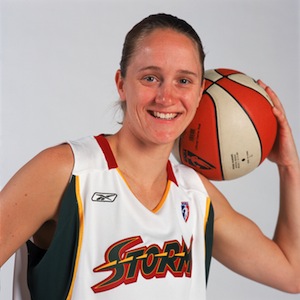
1998 / DAVID SEGUI, Baseball
1998 / KAREN THORNDIKE, Sailing
When Payton won the 1997 Star of the Year award, he ended a 17-year drought for his team, which hadn’t produced a winner since center Jack Sikma in 1980 (see Wayback Machine: Sports Star Of Year 1980-89).
Heading into the 1998 program, Todd MacCulloch bucked an even longer famine: In the 63-year history of the SOY event, no UW men’s basketball player was selected, not even Bob Houbregs, who took the Huskies to their first Final Four and led the nation in scoring (25.6 ppg) in 1953 (see Wayback Machine: Sports Star of Year 1950-59).
In fact, since the arrival of the SuperSonics in 1967-68, only two UW men’s basketball players had been nominated: Detlef Schrempf in 1984 and Christian Welp in 1986.
A 7-foot center, MacCulloch had led the Huskies to their first appearance in the NCAA Tournament’s Sweet Sixteen, (which didn’t exist in Houbregs’ day), averaging 18.6 points and 9.7 rebounds. He was the sixth player in NCAA history to lead the nation in field goal percentage two years in a row (he would three-peat in 1999, becoming the second to accomplish that feat).
In the men’s balloting, MacCulloch faced off against two football players, Chad Brown of the Seahawks and Joe Jarzynka of the Huskies, thoroughbred owner Mike Pegram, and David Segui, first baseman of the Mariners.
Brown received an AFC invitation to the Pro Bowl after leading the conference in tackles with 150, most by a Seahawk since Terry Beeson’s 153 in 1978. Jarzynka led the Huskies in punt returns, endeared himself to Husky Stadium crowds by refusing to call for a fair catch, and scored on a 91-yard return against California, third longest in school history. He also handled the placekicking chores.
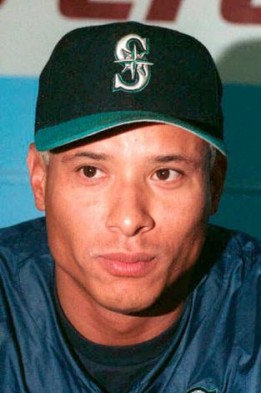
Owner of several McDonald’s franchises in Washington state, Pegram reached the head table as the owner Real Quiet, the 1998 Kentucky Derby and Preakness winner.
Segui, who batted .305 with 19 home runs, got there largely because the Mariners big guns, Ken Griffey Jr. (1989), Edgar Martinez (1992) and Alex Rodriguez (1996), already won Star of the Year awards and were therefore ineligible.
That Segui ultimately won over MacCulloch, Brown, Jarzynka and Pegram only underscored the long-established reality that in Star of the Year voting, especially among male nominees, the highest public profile usually prevailed.
Not so on the womens side of the ballot, which featured American Basketball League Rookie of the Year Shalonda Enis, Pac-10 discus winner Aretha Hill of the UW, national champion weightlifter Melanie Kosoff from Bonney Lake, and UW basketball guard Jamie Redd, the school’s all-time leading scorer.
The winner: Karen Thorndike, the first woman to sail solo around the world in a feat of amazing persistence.
It took Thorndike eight years of planning and three attempts over a four-year span (1995-98) for the Snohomish resident to sail solo around the five Southern Hemisphere capes.
Her first attempt, in 1995, ended when a storm off the Oregon Coast damaged her boat. Her second try was rebuffed near Nicaragua when her boat was struck by lightning. Her third attempted took her to Hawaii, Tahiti and South America.
After rounding Cape Horn, Thorndike had to be rescued in stormy seas off the Falkland Islands when she became ill. Four months later, she resumed her voyage, only to run into another delay — waiting out the Southern Hemisphere winter near Argentina.
Thorndike resumed her journey Nov. 1, 1997, and made a successful return to San Diego Aug. 18, 1998, having sailed 33,000 miles.
1999 / MARQUES TUIASOSOPO, Football
1999 / BECKY NEWBRY, Softball
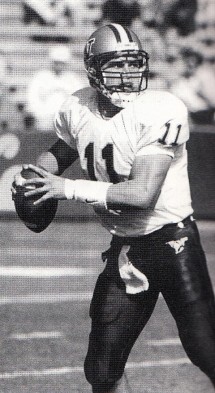
Between 1990-00, Seahawks defensive tackle Cortez Kennedy earned a franchise-record eight Pro Bowl invitations, made first-team All-Pro three times, and won the 1992 NFL Defensive Player of the Year award.
Significant about Kennedy’s Associated Press accolade: he became only the third player in history to win while playing on a losing team (2-14), joining Lawrence Taylor of the 1982 New York Giants and Reggie White of the 1987 Philadelphia Eagles.
Kennedy received Star of the Year three times in the 1990s — 1991 (lost to Steve Emtman), 1992 (to Edgar Martinez) and 1999, when he faced off against Vin Baker of the Sonics, Mariners pitcher Jamie Moyer, University of Arizona All-America basketball player Jason Terry, a former standout at Franklin High, and UW quarterback Marques Tuiasosopo.
Kennedy’s principal competition for the award seemed to come from Baker, who averaged 19.2 points and 8.0 rebounds in his first season with the Sonics, stats that earned him his first All-Star appearance on Seattle’s behalf, and Moyer, who went 14-8 with a 3.87 ERA for the Mariners.
But Tuiasosopo did something too compelling to ignore, and it had little to do with his leading the Huskies to a Holiday Bowl appearance opposite Kansas State.
On Oct. 30, 1999, in a 35-30 victory over Stanford, the UW quarterback passed for a career-high 302 yards and ran for a career-high 207, becoming the first player in NCAA history to accomplish the 300/200 double.
Prior to Tuiasosopo, only three players rushed and passed for more than 200 yards in a game, and only six quarterbacks managed a 300-100 double. Tuiasosopo also ran for a pair of touchdowns and threw a TD pass to Gerald Harris.
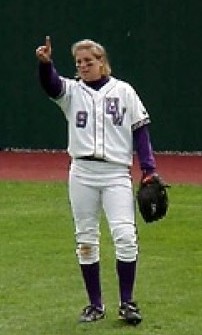
When UW softball star Becky Newbry joined Tuiasosopo as Star of the Year winners, the Huskies had their first double winners since 1994, when Napoleon Kaufman and Rhonda Smith became the first Male and Female Sports Stars of the Year.
Newbry defeated two weightlifters, Lea Foreman (set American records in the snatch and clean and jerk) and Melanie Kosoff-Roach (three-time national champion at 53 Kg), UW athletic director Barbara Hedges, and rising swimming star Megan Quann (gold medal, Pan Pacific Championships).
Newbry saved her best season for last, making first-team All-America after hitting .436. That average ranked second in the Pac-10, 17th in the nation and No. 2 on UW’s season-best list.
Newbry finished her career ranked in UW’s top 10 in every offensive category, including first in triples (16) and second in games played (266), runs (181) and hits (286).
She became the program’s first three-time All-American while breaking the unofficial position record, playing every spot on the field except pitcher during her career.
In addition to her Star of the Year accolade, Newbry became the first softball player to earn UW’s Female Athlete of the Year award.
————————————————
ALSO SEE
Man Of The Year Winners (1935-76)
Star Of The Year Winners (1977-2011)
Wayback Machine: Sports Star Of Year (1935-49)
Wayback Machine: Sports Star Of Year (1950-59)
Wayback Machine: Sports Star Of Year (1960-69)
Wayback Machine: Sports Star Of Year (1970-79)
Wayback Machine: Sports Star Of Year (1980-89)
————————————————
Many of the historic images published on Sportspress Northwest are provided by resident Northwest sports history aficionado David Eskenazi. Check out Davids Wayback Machine Archive. David can be reached at (206) 441-1900, or at seattlesportshistory@gmail.com
————————————————–
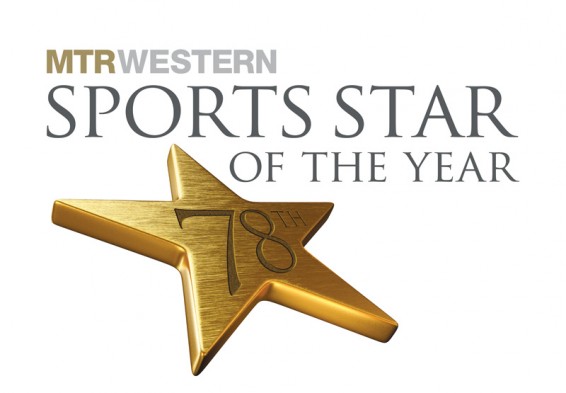 The MTR Western Seattle Sports Star of the Year awards program is Friday at Benaroya Hall. Created by Royal Brougham and the Seattle Post-Intelligencer in 1936 and currently presented by the Seattle Sports Commission, the MTR Western Star of the Year recognizes professional and amateur athletic achievement. Tickets can be purchased at benaroyahall.org or by calling 206-215-4747. The top-priced ticket includes admission to the show and the reception where complimentary beverages, including beer and wine, and heavy appetizers will be provided. You can find more information here.
The MTR Western Seattle Sports Star of the Year awards program is Friday at Benaroya Hall. Created by Royal Brougham and the Seattle Post-Intelligencer in 1936 and currently presented by the Seattle Sports Commission, the MTR Western Star of the Year recognizes professional and amateur athletic achievement. Tickets can be purchased at benaroyahall.org or by calling 206-215-4747. The top-priced ticket includes admission to the show and the reception where complimentary beverages, including beer and wine, and heavy appetizers will be provided. You can find more information here.

3 Comments
Maybe they didn’t win man of the year because they weren’t men.
Debbie Armstrong won gold in the GS not the downhill.
Not one Coug?!?! BS! Future NFL HOFer Drew Bledsoe maybe…